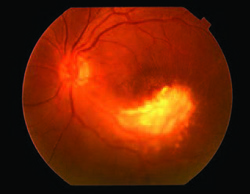 CMV retinitis in the left eye of a
CMV retinitis in the left eye of a
10-year-old Thai child with HIV. Photo courtesy of D. Patikulsila, M.D., and
V. Sirisanthana, M.D., Chiang Mai University, Thailand.Cytomegalovirus (CMV) retinitis once affected up to one- third of HIV-positive people, causing vision loss and even blindness, but it has been nearly eliminated in patients with access to antiretroviral therapy (ART). However, it remains prevalent in resource-limited settings due to the high cost of treatment (see page 8) and a lack of trained ophthalmologists who can diagnose the condition.
CMV is a common virus that most people around the world are infected with by the time they are adults. The infection is usually controlled by the immune system and causes no serious consequences. But it can “reactivate” in HIV-positive people with severely impaired immune systems, causing inflammation of the retina, or retinitis. The disease can be effectively treated with antiviral medications, including oral valganciclovir, and by strengthening HIV-positive patients’ immune systems through ART.
A recent systematic review of research on CMV retinitis in resource-limited settings analyzed 65 studies, including data on 20,280 HIV-positive patients from 24 countries in Asia, Africa, and Latin America.1 The prevalence of CMV retinitis among those screened for the disease ranged from 0.2% in a Nigerian study to 71.5% in one performed in Thailand. The overall prevalence was highest in Asia (14%) and lowest in Africa (2.2%). By country, the highest rates were 24.8% in Myanmar (5 studies, 2,928 patients), 24.4% in Thailand (5 studies, 1,397 patients), 15.2% in China (9 studies, 2,357 patients), and 6.8% in India (13 studies, 4,305 patients).
The analysis confirmed a known association between CMV retinitis and low CD4 levels, as 73.4% of the patients had CD4 counts <50 cells/mm3, 15.6% had CD4 between 50 and 100 cells/mm3, and 8.3% had CD4 between 100 and 200 cells/mm3. Despite the expansion of ART over the last decade, the prevalence of CMV retinitis did not significantly change over time, and actually increased from 11.8% in the period 1993–2002 to 17.6% between 2009 and 2013.
These findings provide a global perspective on the persistent burden of CMV retinitis in HIV-infected patients in resource-limited settings, raising concerns about the lack of CMV retinitis screening programs targeting these patients, and emphasizing the importance of addressing barriers to treatment access.
- Ford N, Shubber Z, Saranchuk P, Pathai S, Durier N, O’Brien D, Mills EJ, Pascual F, T Hoen E, Holland GN, Heiden D. Burden of HIV-related CMV retinitis in resource-limited settings: a systematic review. Clinical Infectious Diseases. 2013 Jul. 29. [Epub ahead of print]